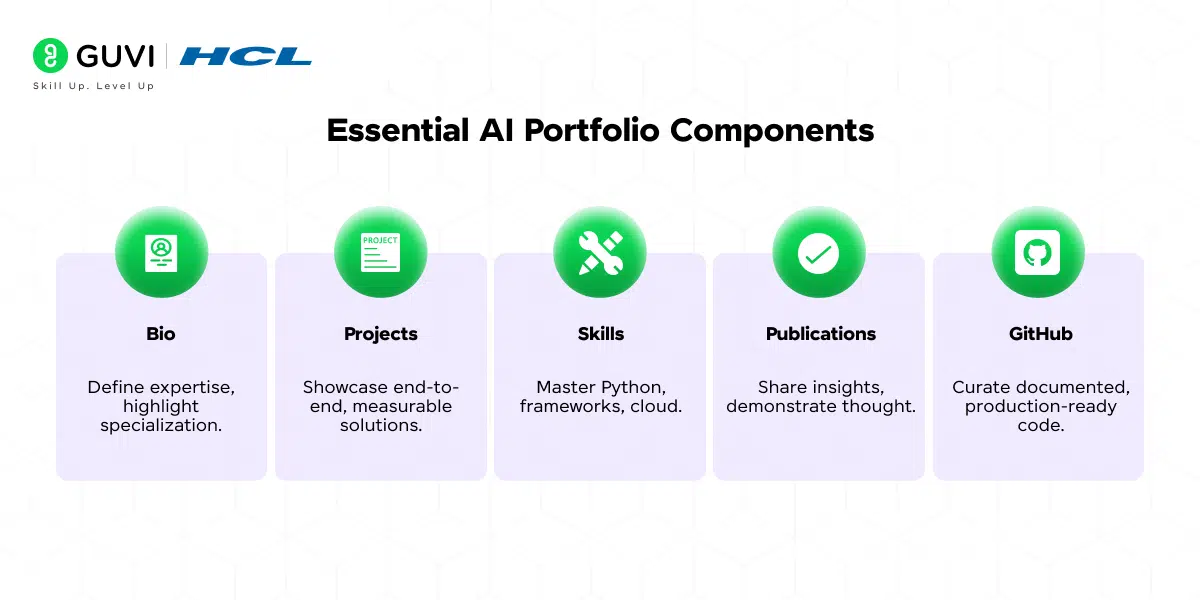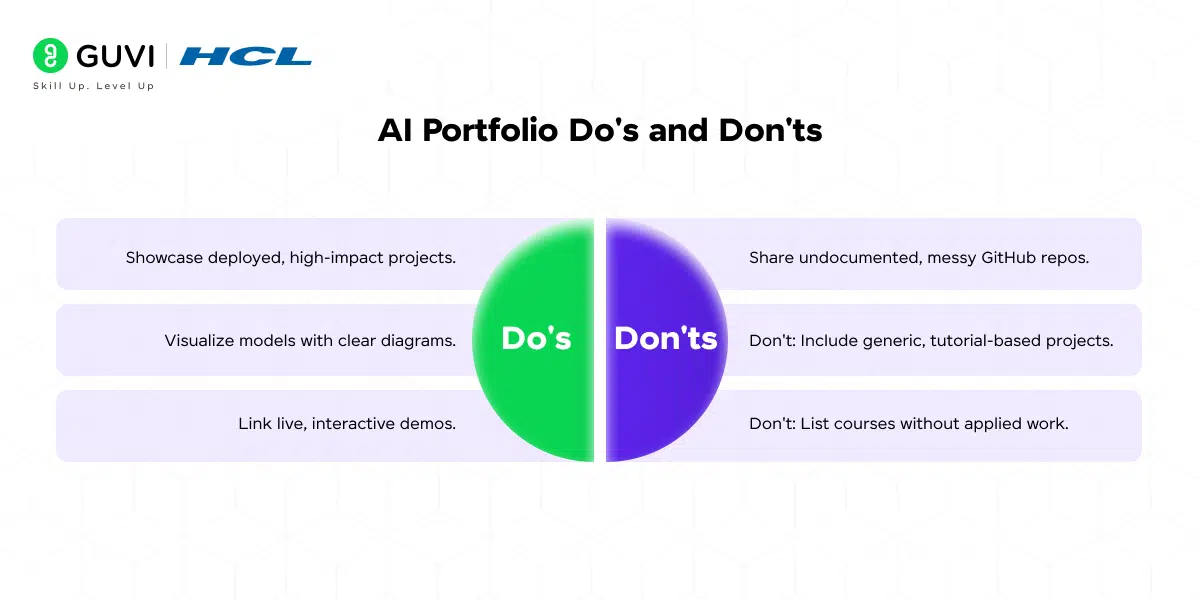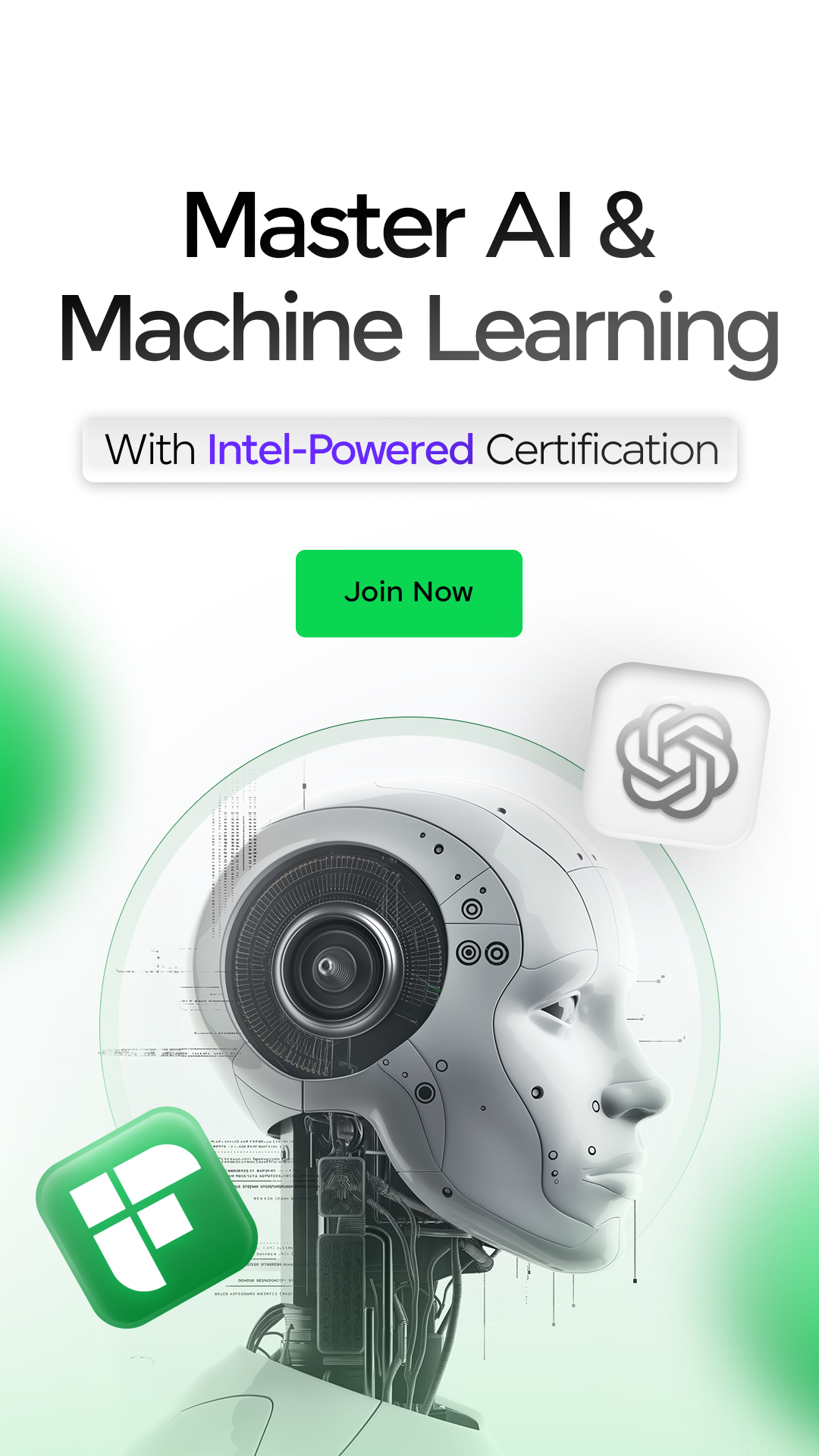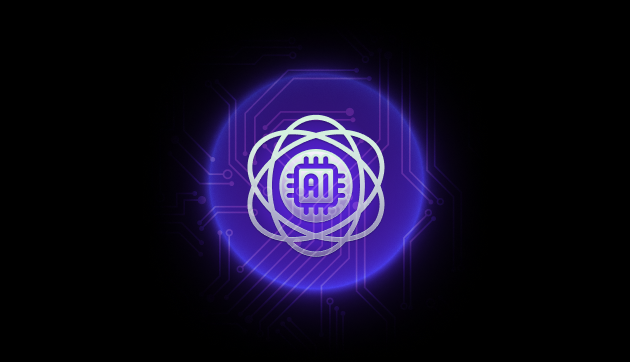
Artificial Intelligence Professional Portfolio
Aug 04, 2025 6 Min Read 2924 Views
(Last Updated)
In 2025, saying you’re “interested in AI” isn’t enough. Recruiters aren’t just scanning resumes anymore – they’re inspecting your GitHub commits, your Kaggle notebooks, and your AI experiments.
Why? Because AI roles are evolving fast, and companies want proof of skill, not just potential.
With the demand for AI/ML roles surging by 39% in 2024 and projected to rise another 30–35% this year, India’s AI job landscape is becoming fiercely competitive.
Applying for roles like AI/ML engineer, prompt engineer, data scientist, or AI product manager? A well-crafted portfolio is no longer optional – it’s your digital proof of work.
Unlike a resume that lists skills, a portfolio shows how you’ve applied them in real-world contexts, with measurable outcomes. It demonstrates:
- How you structure and solve problems
- How deep your understanding goes beyond tutorials
- How does your work connect to business or product goals
Think of it this way:
In AI, your portfolio is your prototype. It tells employers, “Here’s what I’ve built. Here’s how I think. Here’s how I can create value.”
This guide on Artificial Intelligence professional portfolio will walk you through exactly what to include (and what to skip), how to structure your portfolio across different AI roles, and how to make it irresistible to hiring managers, recruiters, and collaborators alike.
Table of contents
- Key Components of an Artificial Intelligence Professional Portfolio
- What Not to Include in Your Artificial Intelligence Professional Portfolio
- Resume vs Portfolio: The Ultimate Comparison for AI Professionals (2025)
- Tips for Showcasing Your Skills and Experience
- Want Projects That Impress Recruiters?
- Conclusion
- FAQs
- How to create a portfolio for a job?
- Are portfolio and CV the same?
- Can I send a portfolio instead of a CV?
- How do I create my own portfolio?
- How many pages should a digital portfolio be?
Key Components of an Artificial Intelligence Professional Portfolio
Imagine walking into a room filled with equally qualified AI professionals – same certifications, same degrees, even similar GitHub activity. What makes you unforgettable?
It’s not just the code you write. It’s how you present the story behind it.
Think of your AI portfolio as a product demo for your brain. It’s not just showing what you know – it’s how you think, how you build, and how your work fits into the real world. Below are the non-negotiable elements your portfolio needs to stand out in today’s hiring climate.

- About Me
If your portfolio were a Netflix series, this would be the 30-second teaser that makes someone binge-watch the rest.
Keep it tight, human, and professional. Include:
- A crisp 3–5 line bio
- A clear headline (e.g., “AI Engineer focused on NLP in healthcare workflows”)
- Profile links — GitHub, LinkedIn, personal site
- Optional: a friendly, professional photo
Why it matters: It sets the tone. It tells visitors what kind of problems you like to solve, and how you fit into the AI landscape, in just a few seconds.
- Projects
This is the meat of your portfolio. If your skills were a band, these projects would be the chart-toppers.
What to showcase:
- 3–5 high-quality, end-to-end projects
- Problem → Approach → Result (keep it visual when possible)
- Charts, model architectures, even screenshots of working UIs
- GitHub, Colab, or live demo links
Why it matters: Projects are proof that you can move from theory to execution. And that’s what hiring teams are paying attention to.
- Technical Skills
Every craftsman is judged by their tools — and how well they use them. This is your snapshot.
Organize clearly:
- Languages: Python (non-negotiable), R, SQL, etc.
- Libraries: TensorFlow, PyTorch, Scikit-learn, etc.
- Cloud & MLOps: Docker, Kubernetes, SageMaker, Azure ML
- Specializations: Hugging Face, OpenCV, LangChain (if relevant)
- Proficiency labels: Basic / Intermediate / Expert
Why it matters: Recruiters scan this like a checklist. ATS bots do too. Make their job easy, and you’re already ahead.
- Publications & Blogs
If your projects are in your hands, this is your voice.
Add:
- Research papers (published or under review)
- Blog posts that simplify complex AI topics
- Thought pieces on trends or ethical considerations
Why it matters: Communication is gold in AI. If you can build and explain, you’re rare. Hiring managers know it.
- Certifications
Think of these like verified badges. They don’t make you great, but they do make you searchable and trustworthy.
List:
- Role-relevant certifications (e.g., AWS ML Specialty, Google ML Engineer)
- Completion of rigorous online programs (Fast.ai, DeepLearning.ai)
- Academic specializations
Why it matters: When recruiters are choosing between 2 solid candidates, certifications are often the tie-breaker. They can also influence starting salary.
- GitHub
A good GitHub isn’t just a code dump — it’s a museum of how you think.
Stand out with:
- Neatly organized, documented repos
- Clear READMEs with setup instructions and use cases
- Open-source contributions that show collaboration
- Annotated notebooks that teach, not just show
Why it matters: Hiring managers are looking here even before they speak with you. What they find (or don’t) could make or break the next step.
- Real-World Impact
Here’s where you shift from “I built this” to “This is what it did in the real world.”
Add:
- Deployed projects (on APIs, websites, internal tools)
- Freelance/consulting work with tangible results
- Hackathon wins or Kaggle leaderboard placements
- Social impact projects (agri-tech, med-tech, etc.)
Why it matters: Artificial Intelligence that lives only in Jupyter isn’t enough. Showing business or community impact helps you cross the line from ‘skilled’ to ‘hired’.
What Not to Include in Your Artificial Intelligence Professional Portfolio
A portfolio is not a dump of everything you’ve ever done. It’s a curated space that should reflect quality, relevance, and clarity.

Here’s what to leave out if you want your portfolio to work in your favor:
- Toy Projects with No Business Context or Depth
Basic models like MNIST digit recognizers or Titanic survival predictions are useful for learning, but they don’t show depth or real-world thinking. If a project doesn’t solve a practical problem or simulate a real use case, it won’t stand out.
What to do instead: Focus on projects that apply to industry contexts or show clear impact, even if they’re small in scale.
- Unexplained or Unmaintained GitHub Repos
A GitHub repo without a clear README, comments, or documentation doesn’t help anyone. It raises questions about how well you can communicate your work or maintain production-grade code.
What to do instead: Add a simple README explaining what the project does, how to run it, and the outcome.
- Screenshots of Jupyter Notebooks Without Interactivity
Static screenshots tell very little. They can’t show your logic, execution, or results in action.
What to do instead: Share working links to Colab notebooks or interactive dashboards. Let your reviewers test or explore the output themselves.
- Overloading with Courses Instead of Original Work
Listing 10 courses without any application of the knowledge signals passive learning. Recruiters care more about what you’ve built than what you’ve watched.
What to do instead: For every few courses, include at least one applied project that uses the concepts.
- Generic Code Copied from Tutorials
Projects that look exactly like standard tutorials show no original thought or skill. Recruiters recognize copied work instantly.
What to do instead: Build on what you learn. Use different datasets, tweak the model, or deploy it in a new context to make it your own.
Your portfolio should reflect initiative, clarity, and relevance. If a piece of content doesn’t add value, remove it. A few solid, well-presented projects will always beat a long list of half-finished or unoriginal work.
Resume vs Portfolio: The Ultimate Comparison for AI Professionals (2025)
| Aspect | Resume | Portfolio |
| Primary Purpose | Quick snapshot of qualifications for ATS and recruiters | Deep dive into skills, projects, and real-world impact |
| Best Used For | Job applications (LinkedIn, Naukri, company portals) | Showcasing work to hiring managers, clients, or freelance opportunities |
| Format | 1-2 pages, text-heavy, structured (reverse-chronological) | Interactive, visual, project-based (web/GitHub/PDF) |
| Key Content | – Education – Work Experience – Skills (bullet points) – Certifications – Contact Info | – Projects with code/results – Live demos – Technical blogs – GitHub repos – Case studies |
| Advantages | – Fast to scan – ATS-friendly – Standardized format – Good for initial screening | – Demonstrates skills – Visual and engaging – Proves real-world ability – Stands out in competitive markets |
| Limitations | – Limited depth – Doesn’t showcase projects – Generic for AI roles | – Time-consuming to build – Not always ATS-friendly – Overkill for some traditional roles |
| When to Use | – Applying via job portals – Career fairs – Initial recruiter screening | – AI/ML job interviews – Freelancing/consulting – Tech-heavy roles (research, startups) |
| Complementary Value | A resume gets you the interview | Portfolio wins the job by backing up resume claims with proof |
| Ideal for AI Careers | Necessary but insufficient alone | Critical for standing out in 2025’s skill-driven market |
Takeaway message: You don’t need to choose between a resume and a portfolio. You need both, one opens the door, the other builds trust. In a competitive AI market, especially in India’s hiring landscape, combining a clean, keyword-optimized resume with a strong, project-rich portfolio gives you a clear edge over others.
Tips for Showcasing Your Skills and Experience
These aren’t the usual “add your projects” tips. These are the moves that make recruiters pause, click, and remember your name.
- Make It Visual. Let Your Work Speak Without Words
Use architecture diagrams, dashboards, and flowcharts to show how your AI solutions work.
Don’t just write “built a fraud detection model.” Show the pipeline, display the confusion matrix, and add a performance comparison chart.
A well-placed chart is worth more than 200 words on accuracy.
- Build a Personal Site That’s More Than a Link Dump
Platforms like GitHub Pages, Notion, or Webflow let you design a clean, distraction-free space.
But here’s the real tip: treat it like a product. Add version updates, navigation logic, CTAs, and searchability.
Your portfolio site isn’t a digital diary. It’s your AI showroom.
- Explain Your Thought Process Like You’re Teaching It
What problem were you solving? Why did you choose that model? What did you tweak when the results were poor? Use each project to narrate your thinking, tradeoffs, and experiments.
Projects with context show maturity. Projects without it look like homework.
- Shallow Projects Don’t Stand Out
You don’t need 10 projects. You need three solid ones with clear business outcomes or deployment. Even one project, done right — with documentation, visualizations, performance metrics, and real-world context — can beat a page full of toy demos.
In AI portfolios, depth signals credibility.
- Link to Live Work. Don’t Just Say It, Show It
Live notebooks. Hosted APIs. Interactive dashboards. When you link to Colab notebooks, Hugging Face spaces, or Streamlit apps, you’re not just claiming a skill. You’re proving it in real time.
Recruiters love clicking links that work.
- Update It Like a Product, Not a Certificate Folder
Too many portfolios go stale. Set a 30-day check-in to:
- Add new learnings or tools
- Replace older code with cleaner versions
- Archive experiments with a “What I learned” section
An updated portfolio shows you are actively learning, not just showcasing history.
- Bonus Power-Move: Add a “Failures and Fixes” Section
Showcase projects that didn’t work out, and what you learned. This reflects your ability to debug, adapt, and problem-solve under real-world constraints.
Real engineers fail fast, fix faster, and document both.
- Leave a Digital Trail That Feeds Back to Your Portfolio
Write LinkedIn posts breaking down your projects. Create short Loom videos explaining your workflow. Link back to your site or repository.
Let your portfolio become the destination that other content leads to.
Most AI portfolios look the same. A few GitHub links. A line about TensorFlow.
The ones that stand out feel alive, intentional, and well-crafted. They show not just what you’ve done, but how you think and why it matters.

Want Projects That Impress Recruiters?
If you’re serious about building a portfolio that recruiters can’t ignore, it’s not just about what you learn, it’s about how you apply it. That’s where GUVI’s Zen Class in Artificial Intelligence and Machine Learning comes in.
Unlike theory-heavy courses that leave you guessing, this program is completely project-driven. You’ll work on real-world AI applications, master tools like Python, TensorFlow, and NLP libraries, and even deploy models that can go straight into your portfolio.
If you’ve been stuck in tutorial loops or struggling to find impactful projects, this course could be the shortcut you’ve been waiting for, and the bridge between learning and getting hired. Check it out here
Conclusion
In a field where everyone knows Python and everyone has taken a Coursera course, your AI portfolio is the only proof that you can actually build something that works. It’s more than a collection of projects — it’s your silent pitch to every recruiter, hiring manager, and collaborator who lands on your page.
Think of your portfolio not as a formality, but as a living product. One that reflects how you solve problems, how you write code, how you learn, and how you think. And in a market that moves as fast as AI does, this single asset can fast-track opportunities you didn’t even know existed.
So don’t just make a portfolio. Design it. Curate it. Evolve it.
Make it so good that it stops people mid-scroll.
Because in 2025, resumes may get you seen.
But portfolios? They get you hired.
FAQs
1. How to create a portfolio for a job?
Start by showcasing 3–5 impactful projects with clear problem statements, your approach, results, and code/demo links. Include skills, certifications, and visuals to highlight your thought process.
2. Are portfolio and CV the same?
No. A CV lists qualifications and experience, while a portfolio shows proof of work through real projects, visuals, and interactive demos. Both serve different purposes and complement each other.
3. Can I send a portfolio instead of a CV?
You shouldn’t. Most recruiters expect a CV for initial screening. Use the portfolio as an added asset, a clickable link that strengthens your credibility and proves your hands-on skills.
4. How do I create my own portfolio?
Use platforms like GitHub Pages, Notion, or Webflow. Keep it clean, updated, and project-focused. Include code, visuals, metrics, and insights to make your experience stand out professionally.
5. How many pages should a digital portfolio be?
There’s no fixed number. Aim for clarity over length, typically, 1–3 main pages with sections like About, Projects, Skills, and Contact. Make it easy to navigate and focused.





























Did you enjoy this article?